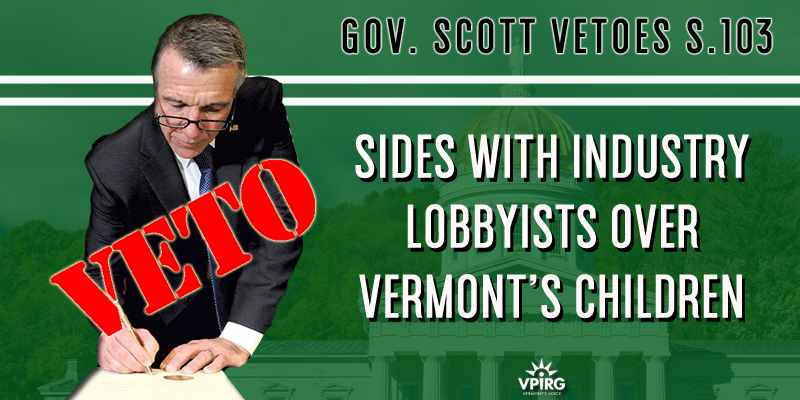Yesterday, Gov. Phil Scott vetoed the first major bill to reach his desk as a response to the 2016 discovery of the toxic chemical PFOA in drinking water in Bennington County and elsewhere around Vermont.
The bill, S.103, was aimed primarily at protecting children from toxic chemicals in their toys, clothing, utensils and other products. Legislators had been working on the bill for two years, and it was initially recommended by a diverse working group made up of state officials, industry representatives and public interest advocates.
“There is no legitimate reason for the governor to veto a bill that would help to keep children safe from toxic chemicals,” said Paul Burns, executive director of the Vermont Public Interest Research Group, which advocated for the bill. “When the choice came down to protecting kids or pleasing industry lobbyists, Gov. Scott went with the lobbyists. It’s really a shameful decision.”
The bill vetoed by the governor contained a number of key provisions:
Working Group: The Commissioner of Health would have been empowered to make data-driven decisions to ban or regulate dangerous children’s products after consulting with a diverse Working Group.[1] Current law prevents the Commissioner from taking action against a children’s product unless and until the Working Group initiates the rulemaking process.
Children’s Exposure to Toxins: Current law requires the Health Commissioner to determine that children “will be” exposed to a toxin before regulatory action against a product may be initiated. This standard represents a costly and unreasonable barrier to action, which could lead to unnecessary harm. In contrast, S.103 would have taken a more precautionary approach by requiring the Commissioner to find that there “may be” exposure to a toxic chemical.
Chemical Disclosure: Act 188 (passed in 2014) was supposed to allow regulators and consumers to link known toxins with specific children’s products, based on required reporting from manufacturers. But many manufacturers have failed to provide clear data. S.103 was designed to remedy this problem by requiring manufactures of children’s products to include the Universal Product Code (UPC) when they report that one (or more) of their products sold in Vermont contains a of the chemicals of concern to children.
Drinking Water Testing: The legislation would have required all new drinking water wells to be tested for toxic chemicals such as arsenic, lead, and uranium. This proposal drew broad support in the wake of recent PFOA water contamination problems.
Interagency Coordination and Toxics Use Reduction: S.103 would have established an interagency committee to improve coordination among the numerous state agencies that regulate toxic and hazardous substances. In addition to streamlining reporting requirements, this group would identify opportunities for toxics use reduction among businesses in Vermont.
“At his gun safety bill signing just last week, Gov. Scott rightly asked, ‘Are we truly doing everything we can to make our kids and communities safer?’ To then turn around and veto a bill that would protect our children from cancer-causing chemicals is dumbfounding,” said Lauren Hierl, executive director of Vermont Conservation Voters. “We’ve all watched with concern as our neighbors in Bennington are experiencing the devastation of toxic contamination, and now that the first major bill to respond to that crisis has reached his desk, it’s profoundly disappointing that the Governor chose to side with industry lobbyists rather than our children and communities.”
Children are known to be uniquely susceptible to toxic threats. A letter to Gov. Scott sent last week by four members of the Chemicals of High Concern to Children Working Group – a group established under Act 188, passed in 2014 – highlighted this fact.
The letter urged Gov. Scott to sign S.103, and noted that, “The science is clear that exposure to toxic chemicals early in life can trigger otherwise avoidable disease and dysfunction in children and adults. These negative outcomes can be prevented by avoiding chemical exposure in the first place.”
The authors of the letter included two notable medical professionals: Dr. Ira M. Bernstein, M.D., of the Robert Larner, M.D. College of Medicine at the University of Vermont and UVM Medical Center; and a national expert on children’s environmental health, Philip J. Landrigan, M.D., M.Sc., of the Icahn School of Medicine at Mount Sinai.
The negative outcomes caused by toxic exposures are not merely tragedies for children and their families, they also cost Vermont citizens a tremendous amount of money to manage. Experts estimate that reducing the exposure of children to these toxins could save the state millions of dollars.
“You have to wonder just what it will take for Gov. Scott to finally realize that children exposed to toxic chemicals deserve protection too,” said Burns.

